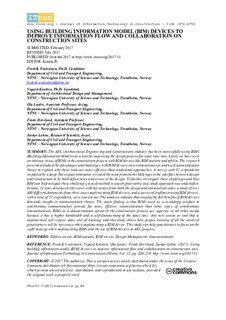| dc.contributor.author | Svalestuen, Fredrik | |
| dc.contributor.author | Knotten, Vegard | |
| dc.contributor.author | Lædre, Ola | |
| dc.contributor.author | Drevland, Frode | |
| dc.contributor.author | Lohne, Jardar | |
| dc.date.accessioned | 2018-06-25T10:59:15Z | |
| dc.date.available | 2018-06-25T10:59:15Z | |
| dc.date.created | 2017-10-09T16:00:32Z | |
| dc.date.issued | 2017 | |
| dc.identifier.citation | Journal of Information Technology in Construction (ITcon). 2017, 22, 204-219. | nb_NO |
| dc.identifier.issn | 1874-4753 | |
| dc.identifier.uri | http://hdl.handle.net/11250/2502827 | |
| dc.description.abstract | The AEC (Architectural Engineering and Construction) industry has been successfully using BIMs (Building Information Models) as a tool for improving the design process for some time now. Lately we have seen an increase in use of BIMsin the construction process with BIM devices like BIM stations and tablets. The research presented studied the advantages and challenges with BIM devices on a construction site and used communication theory to explain why these tools are more effective than traditional approaches. A survey with 82 respondents employed by a large Norwegian contractor revealed the most prominent challenges in the interface between design and construction to be both deficiencies and errors in the design. To further investigate these challenges and how BIM can help mitigate these challenges, mixed-method research plan with a case study approach was undertaken. In total, 24 semi-structured interviews with key actors from both the design and construction sides, a study of over 400 different documents from three cases implementing BIM devices, and a survey of craftsmen using BIM devices, with a total of 73 respondents, were carried out. The analyses indicate that reaping the full benefits of BIM devices demands insight in communication theory. The main finding is that BIMs used as a mediating artefact in synchronous communication provide far more effective communication than other types of synchronous communication. BIMs as a documentation option in the construction process are superior to all other media because it has a higher bandwidth and is self-documenting at the same time. Any new system or tool that is implemented will require some sort of training, and this study shows how proper training of all the involved practitioners will be necessary when implementing a BIM device. This study can help practitioners to focus on the right strategy when implementing BIMs and the use of BIM devices in AEC projects. | nb_NO |
| dc.language.iso | eng | nb_NO |
| dc.publisher | International Council for Research and Innovation in Building and Construction | nb_NO |
| dc.rights | Navngivelse 4.0 Internasjonal | * |
| dc.rights.uri | http://creativecommons.org/licenses/by/4.0/deed.no | * |
| dc.title | Using building information model (BIM) devices to improve information flow and collaboration on construction sites | nb_NO |
| dc.type | Journal article | nb_NO |
| dc.type | Peer reviewed | nb_NO |
| dc.description.version | publishedVersion | nb_NO |
| dc.source.pagenumber | 204-219 | nb_NO |
| dc.source.volume | 22 | nb_NO |
| dc.source.journal | Journal of Information Technology in Construction (ITcon) | nb_NO |
| dc.identifier.cristin | 1503493 | |
| dc.description.localcode | © 2017 The author(s). This is an open access article distributed under the terms of the Creative Commons Attribution 4.0 International (http://creativecommons.org/licenses/by/4.0/), which permits unrestricted use, distribution, and reproduction in any medium, provided the original work is properly cited | nb_NO |
| cristin.unitcode | 194,64,91,0 | |
| cristin.unitcode | 194,61,50,0 | |
| cristin.unitname | Institutt for bygg- og miljøteknikk | |
| cristin.unitname | Institutt for arkitektur og planlegging | |
| cristin.ispublished | true | |
| cristin.fulltext | original | |
| cristin.qualitycode | 1 | |

